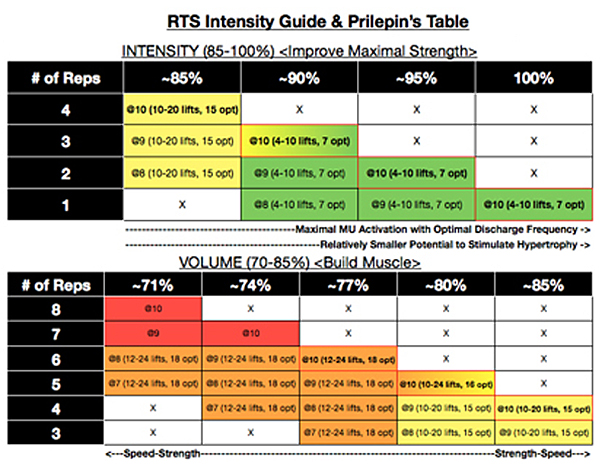
Prilepin-based Bench And Squat Program
Louie Simmons, powerlifting guru and founder of Westside Barbell, has probably been the most influential person in strength training in the last 20 years. Much of Simmons' methodology has been influenced by the work of A.S. Prilepin, a Soviet sports scientist. Prilepin reportedly reviewed the training journals of over 1000 weightlifters in search of the keys to building maximum strength, which he summarized in the following table. Prilepin's Table Percent Reps per Set Optimal # of Reps Total Range of Reps 90% 1-2 7 4-10 Note: This is a strength training table, so it has lower repetitions than normally used for hypertrophy purposes. Remember, Prilepin was summarizing findings of weightlifters, which have very little need for higher repetition work.
Jun 10, 2018 - Prilepin's chart was designed for powerlifters, but the strength training. It's also about how much you can lift BASED ON YOUR SIZE. Of any given movement such as the squat, deadlift, or bench press. Long story short, you can see that strength training program can get very complicated very quickly.
• The first column bases the percentage on a single repetition maximum lift. For instance, if someone's 1RM deadlift is 500 lbs., 90% of that amount would 450 lbs.
• The second column suggests the number of repetitions per set. Notice that as the percentage increases, repetitions decrease. This mitigates fatigue and potential overtraining due to increased stress on the nervous system. • The third column puts forth an optimal number of total repetitions for strength gains. Again, notice that as the percentage increases, the optimal number of repetitions decreases. Pay particular attention to the drop in optimal repetitions from the 80% to the 90% range (an over 50% reduction). This implies that as movement speed slows, nervous stimulation is greater.
• The fourth column is a potential range of repetitions based on the associated percentage. As you can see, the previous column's optimal value is smack dab in the middle of this range. Prilepin likely assumed that any less than the lower number and the trainee would fail to derive enough stimulation; and any more than the higher number would slow the speed of the movement down due to cumulative fatigue. Introducing Time into Prilepin's Table One element left out of this table is the time factor.
In previous writings, Simmons limits time between sets on dynamic effort days to increase workload, i.e. More work in less time. This makes the training session more efficient.
Decreasing rest times in a training session can also enhance hypertrophy. So, the first thing we can do to promote hypertrophy with Prilepin's table is to set a limit to rest times.
The limit, however, should be relative to the other columns on the chart. It might look something like this: Modified Prilepin's Table – The Time Factor Percent Reps per Set Optimal # of Reps Total Range of Reps Rest Period Length 90% 1-2 7 4-10 90-180 sec. Let's suppose that you bench press 300 lbs. Take 70% of that number, which would be 210 lbs.
Since higher reps tend to promote hypertrophy, 4 sets of 6 reps with 210 lbs. And 75 seconds rest between sets would be a logical starting point. You might then progress in the following way. This approach would mitigate the risk of overtraining, provided overall volume and intensity were kept in check. • Week 2 – 4 sets x 6 reps with 210 lbs. And 65-second rest periods. • Week 3 – 4 sets x 6 reps with 210 lbs.
Logiciel dialogys renault. Insert DVD2 and 'Run' auto, click next untill finish 4. Insert DVD1 and 'Run' auto, click next untill finish 3. Insert DVD3 and 'Run' auto, click next untill finish 5. Insert DVD-0 and 'Run' auto, click next untill finish 2.
And 55-second rest periods. • Week 4 – 4 sets x 6 reps with 210 lbs. And 45-second rest periods. On the fifth week, the percentage could be increased and rest periods increased, with the cycle repeated based on rest period manipulation.
Hypertrophy Curveball However, six repetitions or fewer probably isn't ideal for hypertrophy, so what might Prilepin's chart look like if higher reps are incorporated? What follows is an extension of his chart, but clearly, it's not something that he'd likely recommend. Prilepin worked with weightlifters and increased reps decreased efficiency on those lifts. The goal of this hypertrophy training approach is to regulate intensity and bring a rationale to a field that's often nebulous at best. It's not about the 'pump' and it's certainly not about training by 'feel.' Modified Prilepin's Table – The Hypertrophy Factor Percent Reps per Set Optimal # of Reps Total Range of Reps Rest Period Length 90% 1-2 7 4-10 90-180 sec. The middle three columns were changed.